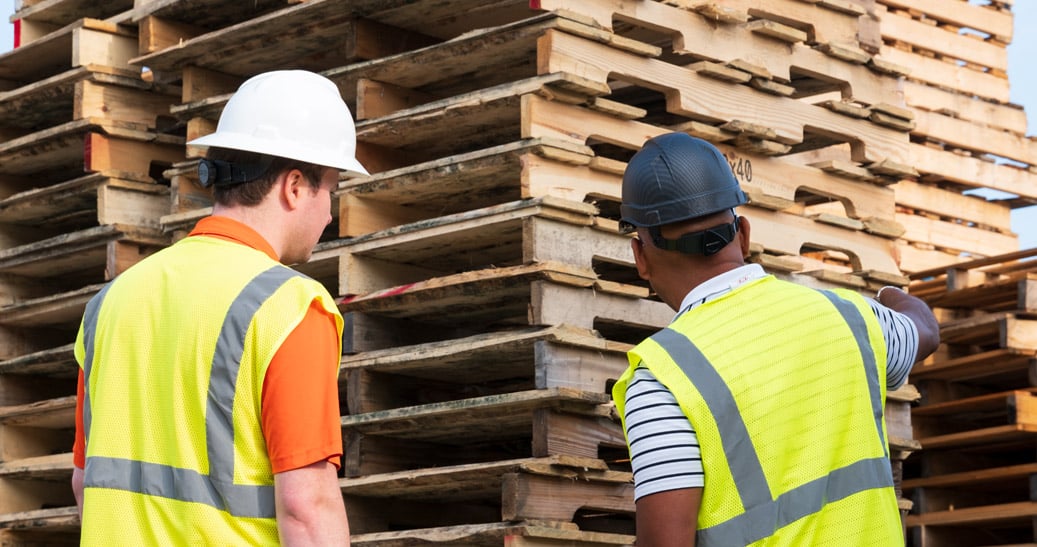Compromised pallets, crates, and wood packing can pose significant risks. Broken pallets endanger the items you’re shipping or storing and the staff moving them. Failure to prevent pallet damage can even be a risk to your customer or end-user.
The good thing is that there are plenty of ways you can prevent pallet damage in the warehouse and during transportation. Some of the ways to avoid the damage include:
Use the right pallet for the right products
Using the correct pallet for the job may appear a no-brainer, but you’d be shocked how many people get it wrong. When palletizing things, make sure that they fit properly on the pallet. Here are some things to consider:
Ensure the item you are shipping isn’t too big for the pallet
Products that protrude from the pallet risk being hit, caught, or bumped during loading, unloading, and transport. Things that are too large for the pallet can also damage the pallet.
When products exceed the capacity of the pallets that transport them, excessive strain on the joints might trigger a failure.
To be on the safe side, always ensure that you put the correct items in your pallet of choice. If your pallet is designed for palletized loads of 1,000 pounds, but you load it with 2,000 pounds, you risk breaking the pallet.
One of the most essential strategies to prevent pallet damage is to use the appropriate weight for the pallet design and to ensure optimum weight distribution.
Ensure the pallet isn’t too big for your item.
The same way an item that is too large for the pallet might cause complications is the same way a pallet that is too large for the item you are shipping can be problematic.
It may appear to be a good idea to have a large buffer between your goods and the pallet’s edge, but this might cause harm to the pallet. This can also strain the joints and result in inappropriate pallet load balancing. Either way can cause breakage and damage.
To avoid damage, ensure that your shipping item fits snugly into the pallet.
Even if you’re using a strapping or banding groove to secure your product to the pallet, be sure it fits flush with the pallet. Remember that deck boards are damaged when exposed to excessive space surrounding the product.
Once the strapping is stretched over the items, the exposed deck boards bear the brunt of the tension and may get damaged.
Protect your wooden pallets.
Wooden pallets are loved by many as they are cost effective, quick to repair, and can support more weight than their plastic equivalents. The downside is that they are susceptible to damage.
The good thing is that there are several things you can do to protect them from damage. Some of these ways include using:
Corner guards to improve vertical stacking strength by absorbing and cushioning edges. This helps to reduce harm to a load during impact.
Cardboard edge guards to stabilize and support the weight while providing a straight edge for strapping oddly shaped objects.
When used together with pallet wrap, top sheets provide additional peace of mind.
For the best outcome, ensure that you get the corner guards and other protective materials from a reputable source such as Millennium Packaging.
Besides protecting the wooden pallets from impact damage, you should also keep them dry at all times.
Many people don’t think much about moisture when dealing with wooden pallets, and it’s a significant hazard. Moisture, in theory, does not harm pallets, but if you work in an area where pallet mold is an important problem, the existence of pallet mold renders your pallets useless.
The mold can lead to damage to pharmaceuticals, foods, and beverages.
Be cautious about how you handle the pallets.
Improper usage of forklifts and pallet jacks is one of the leading causes of damage to wood packing. The single most effective strategy to prevent forklift damage is to ensure that you properly handle the pallets.
When using a forklift, here are best practices that will ensure that you don’t damage your pallets:
- Always enter the pallet (with the tines) at a slow speed
- Before lifting, ensure the forklift tines align and level with the pallet.
- Spread the forklift tines before lifting.
- Do not “short fork” – ensure the forklift tines are far enough into the pallet to guarantee it is complete on the forks.
- Do not hit the pallet blocks or stringers when entering a pallet.
- Lift pallets fully off the ground rather than pushing or dragging them, sometimes called “bulldozing.”
- Never drop or throw pallets.
Other best practices include:
Place the pallets flat on the ground: They may fall and get damaged if you store them upright or on their sides. A fall might harm not just the boards but also the joints. It is the same reason why you should never drop or throw pallets.
Don’t overstack the pallets: You can stack pallets neatly in areas where they are unlikely to be knocked or bumped by forklifts. While this is the case, you should be cautious and ensure you don’t stack the pallets higher than 7 or 8 feet.
This makes it easier to reach and less likely to tip over. Use a forklift if you have a safe spot to stack pallets higher so they don’t topple over.
Don’t step on pallets: You should avoid stepping on pallets as much as possible since it introduces a force the pallet was not built to withstand. If you step on a pallet section not intended to support your weight, you will destroy it. And you don’t want this.
Be ultra-cautious when racking: If you want to rack your pallets, make sure they are intended to be racked the way you desire. If your pallets are not designed to be racked, attempting to rack them may result in failure and damage.
Parting shot
These are tips on how to prevent damage to your pallets. By observing the best practices, you will avoid bottlenecks in your business and, at the same time, protect your staff from the risk of getting injured.





